ByteDance Seed and BYD Lithium Battery Forge Partnership: AI Joint Laboratory to Accelerate Battery R&D
ByteDance Seed and BYD Lithium Battery Forge Partnership: AI Joint Laboratory to Accelerate Battery R&D
Date
2025-06-18
Category
Academic cooperation
On June 11, the Volcano Engine Force Conference announced that ByteDance Seed and Volcano Engine will strengthen their partnership with BYD Lithium Battery. Through initiatives such as joint laboratories, the partners will jointly explore the integration of AI for Science with high-throughput experimentation (HTE) to boost the development of lithium batteries.
Recently, BYD unveiled its Megawatt Flash Charging Battery. This breakthrough technology achieves a 400-kilometer driving range with only 5 minutes of charging, drawing significant attention. A key factor enabling BYD's breakthrough was the early adoption of BAMBOO during R&D. Developed by the ByteDance Seed team, this AI-powered electrolyte framework helps rapidly screen potential electrolyte formulations. Compared to conventional trial-and-error approaches, BAMBOO integrates experimental data to accurately predict key electrolyte properties, including density, viscosity, and ionic conductivity. During the development of the Megawatt Flash Charging Battery, BAMBOO dramatically narrowed down the experimental formulation space, significantly accelerating the R&D process.
Moving forward, the ByteDance Seed team and BYD Lithium Battery will establish an "AI+ High-Throughput Joint Laboratory" to deepen their partnership. Together, they will tackle critical challenges in power batteries, including fast charging, lifespan, and safety issues. The partners will also explore expanded applications of AI technology in battery R&D. This partnership aims to accelerate the discovery of novel materials and formulations, ultimately driving innovation in power battery technology.
Related Research on the BAMBOO Framework
BAMBOO-MLFF (Machine Learning Force Field):
Research Paper: https://www.nature.com/articles/s42256-025-01009-7
GitHub Repo: https://github.com/bytedance/bamboo
BAMBOO-Mix Model: A Unified Predictive and Generative Solution for Liquid Electrolyte Formulation
Preprint: https://arxiv.org/abs/2504.18728
1. AI for Science Delivers Precise Predictions to Accelerate Lithium Battery R&D
As the current leading energy storage technology, lithium batteries depend critically on electrolytes, one of the key components determining battery performance. The physicochemical properties of electrolytes—including density, viscosity, and ionic conductivity—directly impact key battery performance metrics such as fast-charging capability, lifespan, and safety.
However, traditional approaches to electrolyte formulation design rely heavily on experimental trial-and-error methods. This workflow is not only time-consuming and costly but also hard to comprehensively explore complex multi-component systems. Specifically:
- Multi-scale Complexity: Lithium battery systems involve intricate physicochemical processes and multi-scale properties spanning from atomic to macroscopic structures. These processes are highly nonlinear and mutually coupled. Accurate simulation requires multi-scale modeling that spans electronic structure, molecular dynamics (MD), and continuum mechanics. This approach demands substantial computational resources.
-
Accuracy-Efficiency Trade-off: While quantum mechanics simulations offer high accuracy, they incur prohibitive computational costs and face significant scaling challenges for complex and large systems. Conversely, classical force fields are computationally efficient but lack precision required to capture the dynamic behavior of electrolytes.
-
Dynamic Interactions: Conventional methods also struggle to accurately capture the complex intermolecular interactions within electrolytes and the dynamic evolution of solvation structures.
The abovementioned challenges make conventional R&D approaches time-consuming, costly, and difficult to systematize or automate. To overcome these challenges, the ByteDance Seed team developed BAMBOO, an AI-powered framework for electrolytes. By bridging microscopic solvent structures and macroscopic conductivity, BAMBOO enhances the fast-charging performance of lithium batteries. Fine-tuned with experimental data, BAMBOO is able to accurately predict key properties such as electrolyte density, viscosity, and ionic conductivity, providing precise theoretical support for battery R&D.
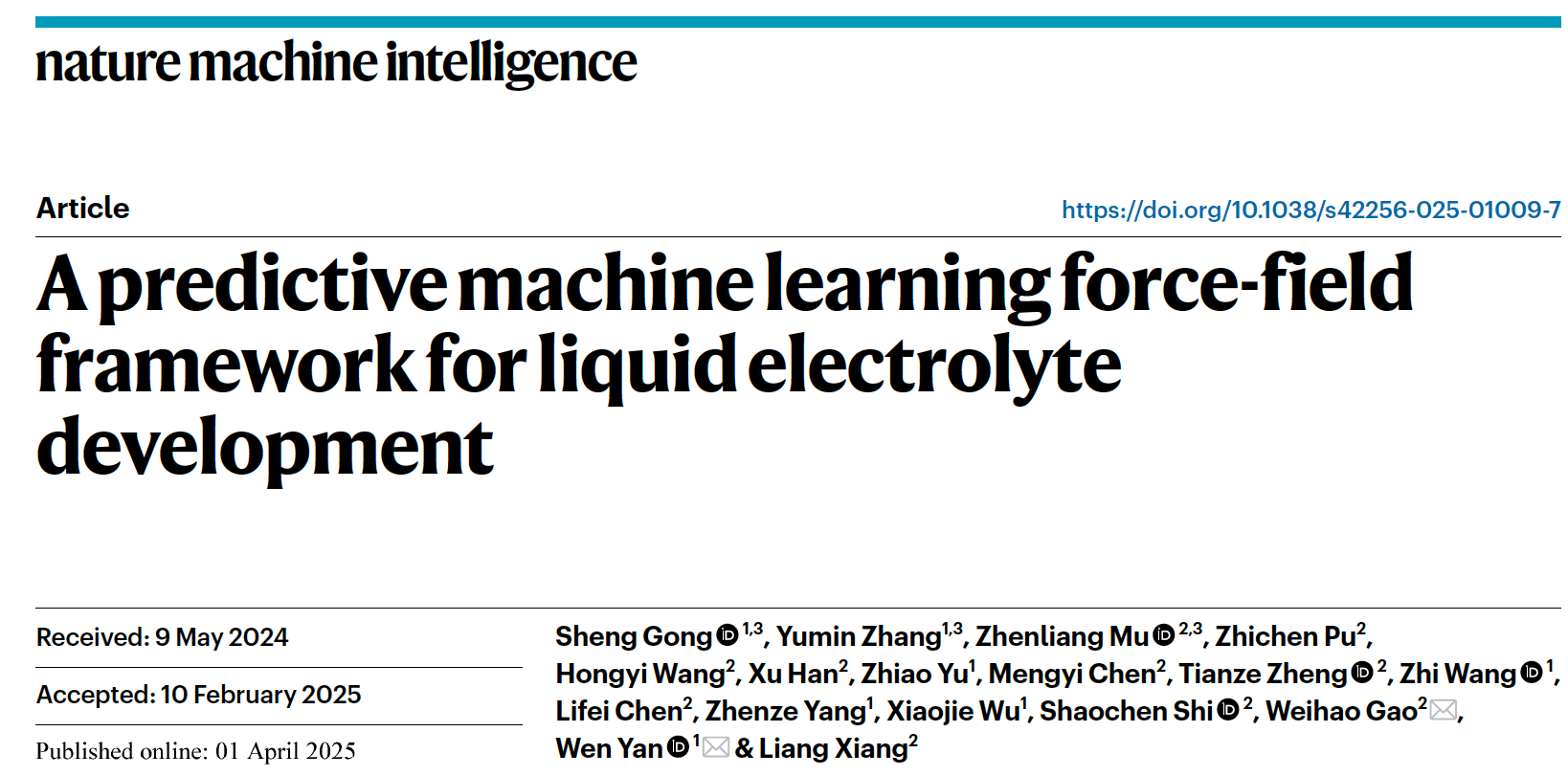
Research on the BAMBOO machine learning force field has been published in Nature Machine Intelligence
2. BAMBOO Framework Enables Rapid Electrolyte Performance Prediction and Potential Formulation Generation
BAMBOO-MLFF is a machine learning force field designed for liquid-phase organic small molecules, with electrolytes as the primary application. Its design integrates physical algorithms from MD with network architectures and training/fine-tuning techniques from AI models.
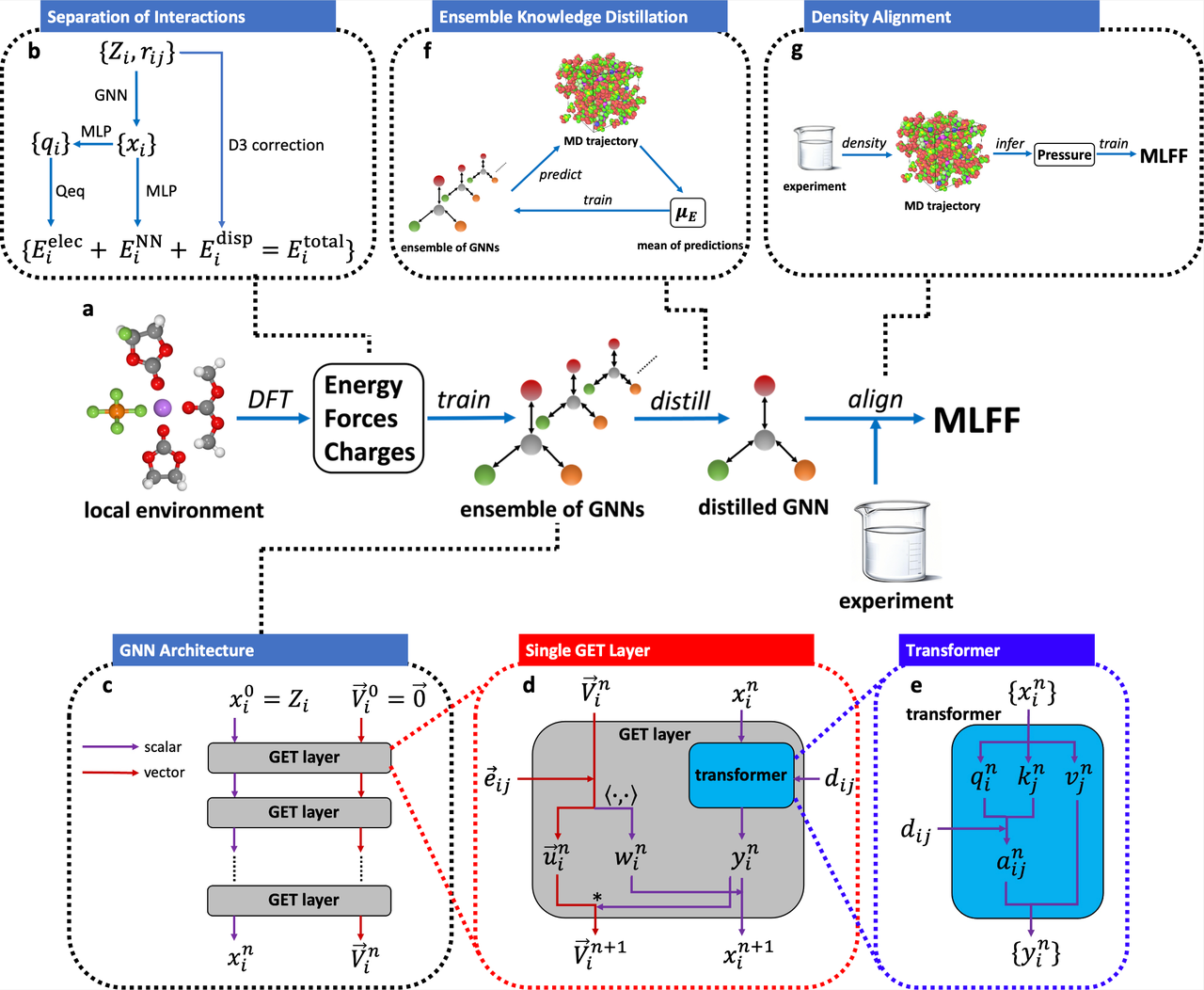
BAMBOO-MLFF Framework Overview
Panel a shows the BAMBOO-MLFF training workflow.
Panel b shows the interaction separation in BAMBOO-MLFF (where MLP denotes multilayer perceptron and Qeq represents the charge equilibration model).
Panels c-e show the GNN, the GET layer within the GNN, and the Transformer architecture within the GET layer, respectively.
Panels f-g show the Ensemble Knowledge Distillation approach and the Density Alignment algorithm in BAMBOO-MLFF, respectively.
Specifically, the BAMBOO-MLFF model design features the following technical innovations:
1. Physics-Machine Learning Integrated Architecture: The model classifies complex intermolecular forces into semi-local, electrostatic, and dispersion interactions for separate modeling. This architecture ensures precise microscopic characterization to enhance the precision and efficiency of MD simulations.
2. Streamlined Rotational Equivariant Network: Graph Equivariant Transformer (GET): The model integrates optimizations across model training data efficiency, prediction accuracy, and inference speed, enabling efficient and accurate AI-powered MD computations.
3. Ensemble Knowledge Distillation and Density Alignment: Ensemble Knowledge Distillation enhances prediction stability by training multiple models and distilling them into one model. Density Alignment leverages minimal experimental data to correlate macroscopic measurements with microscopic simulations, further improving prediction accuracy.
4. High-Precision Property Prediction: By fine-tuning with minimal experimental data, the model outperforms conventional methods in viscosity and conductivity prediction, achieving density prediction errors as low as 0.01g/cm³. Furthermore, the model uncovers microscopic electrolyte mechanisms, such as solvation structure dynamics, delivering molecular-level insights to guide formulation design.
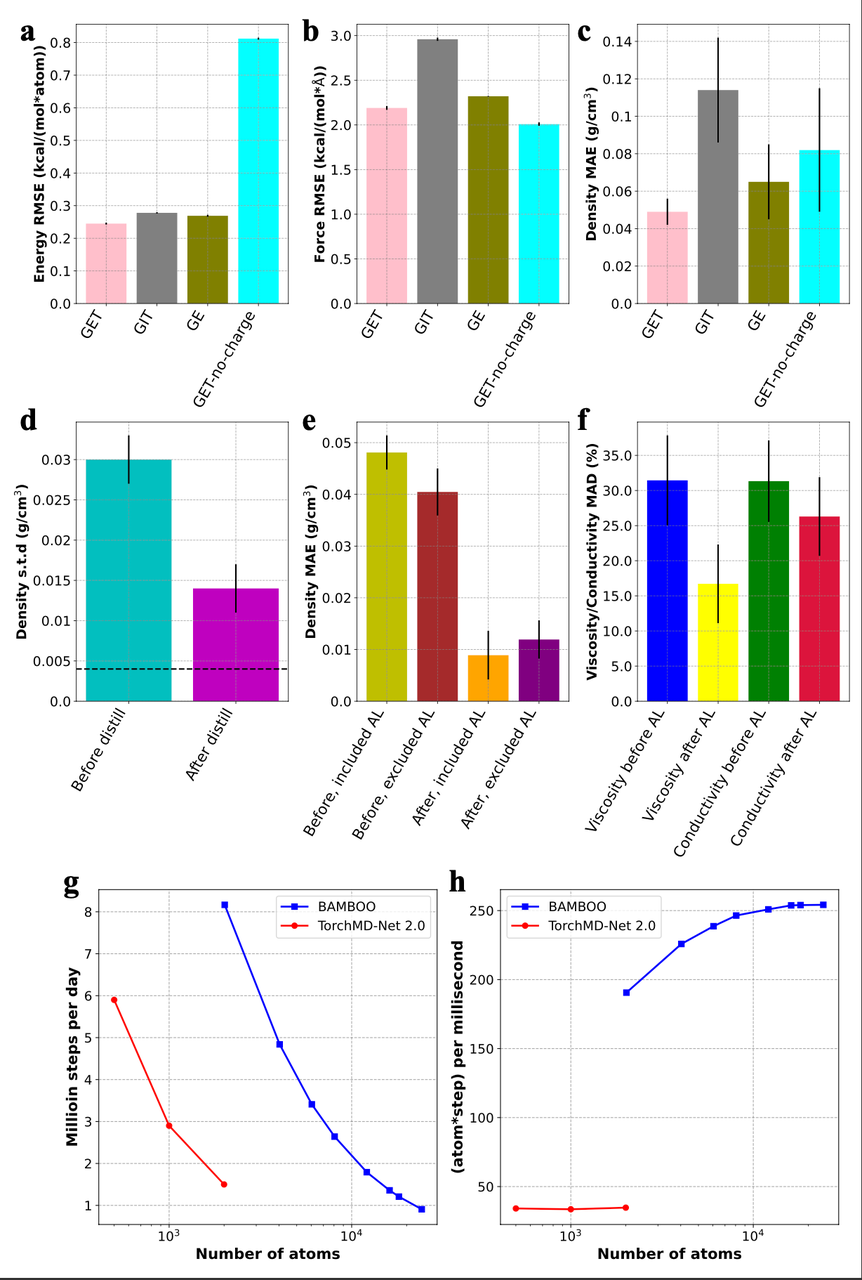
Effects of GET, Ensemble Knowledge Distillation, and Density Alignment in BAMBOO-MLFF
Panels a-c show the effects of equivariance, transformer, and charge on predictions of energy (a), force (b), and density (c), respectively.
Panel d shows the effect of Ensemble Knowledge Distillation on reducing the standard deviation of density from MD simulations by different randomly trained MLFFs.
Panels e and f show the effects of Density Alignment on MD predictions of density, viscosity, and ionic conductivity, respectively.
Panels g and h show the inference speed comparisons between BAMBOO-MLFF and TorchMD-Net 2.0.
Furthermore, to overcome the time-consuming nature of MD methods and navigate the vast chemical formulation search space during broad screening, the Seed team developed BAMBOO-Mix, a unified predictive and generative model for formulation. This model can rapidly predict properties for given formulations (forward prediction) or directly generate potential formulations meeting specific property constraints (reverse generation).
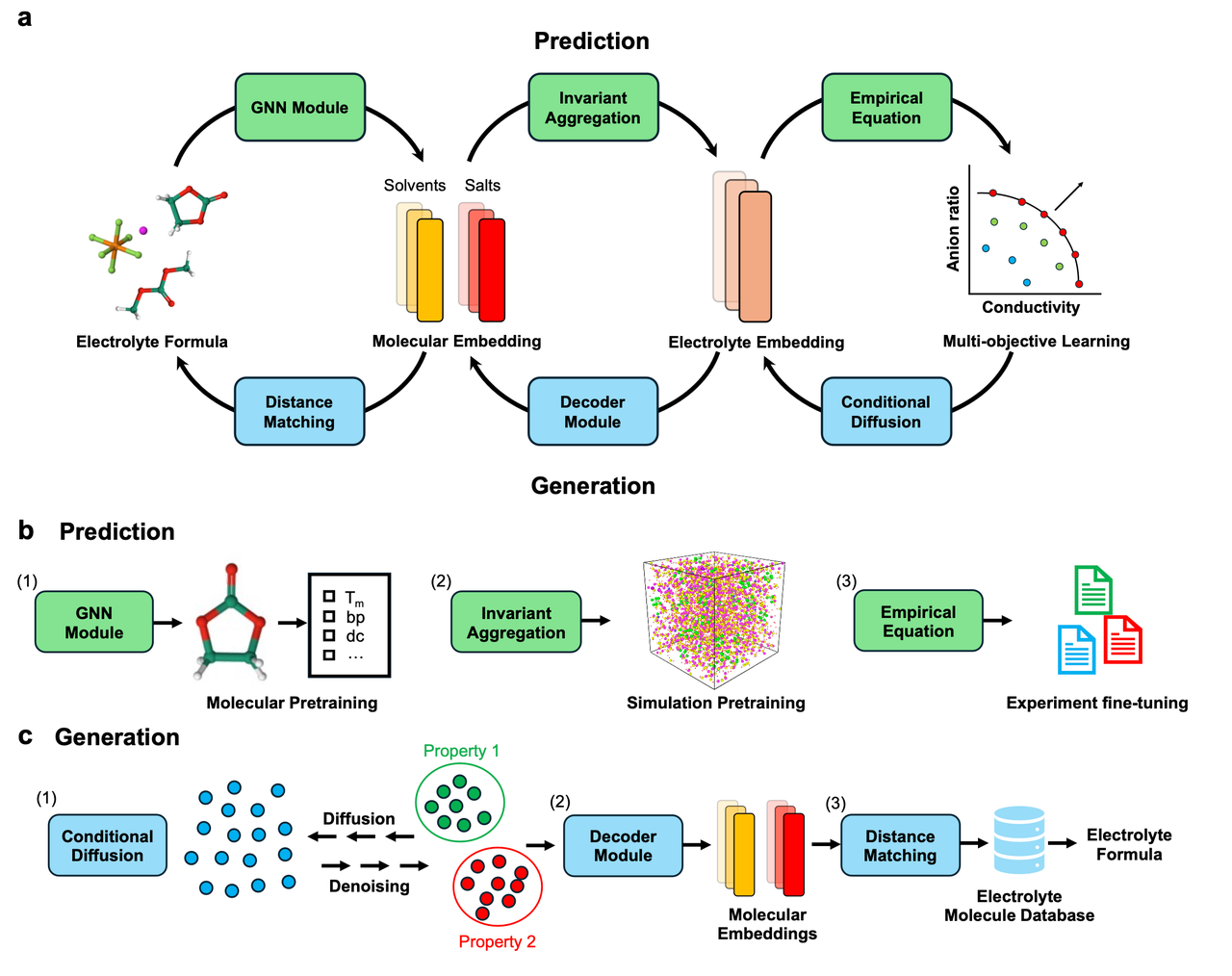
Predictive and Generative Electrolyte Design Workflow
By integrating hierarchical information from both molecules and formulations and employing multi-step training, BAMBOO-Mix can accurately predict formulation properties and rapidly generate potential formulations based on target objectives.
This model features two forward predictive capabilities: predicting molecular properties from single-molecule inputs, and generating conductivity values and partial solvent structure information based on formulation inputs. In forward training, the Seed team constructed a comprehensive dataset from multiple sources, including 240,000 single-molecule entries, 10,000 mixed system experimental data points, and 100,000 MD simulation results. The model extracts molecular fingerprints through Graph Neural Networks (GNN) and employs a permutation invariant aggregation module to predict physical properties of multi-component systems.
Ultimately, the model achieves high accuracy in predicting key parameters, such as conductivity (R² = 0.985) and anion coordination number in lithium-ion solvation structures (R² = 0.953). It can deliver reliable predictions across wide temperature (-50°C to 100°C) and salt concentration (0.1 M to 2.0 M) ranges.
In terms of reverse generation capabilities, the model represents a pioneering exploration of applying diffusion generative models to electrolyte formulation design. Based on a conditional diffusion model, it achieves formulation design under multi-objective constraints. By inputting target conductivity (5–30 mS/cm) and anion coordination ratio (0.1–0.7), the model can instantly generate feasible formulations containing 62 solvent types and 17 lithium salt options. Each generation completes within seconds.
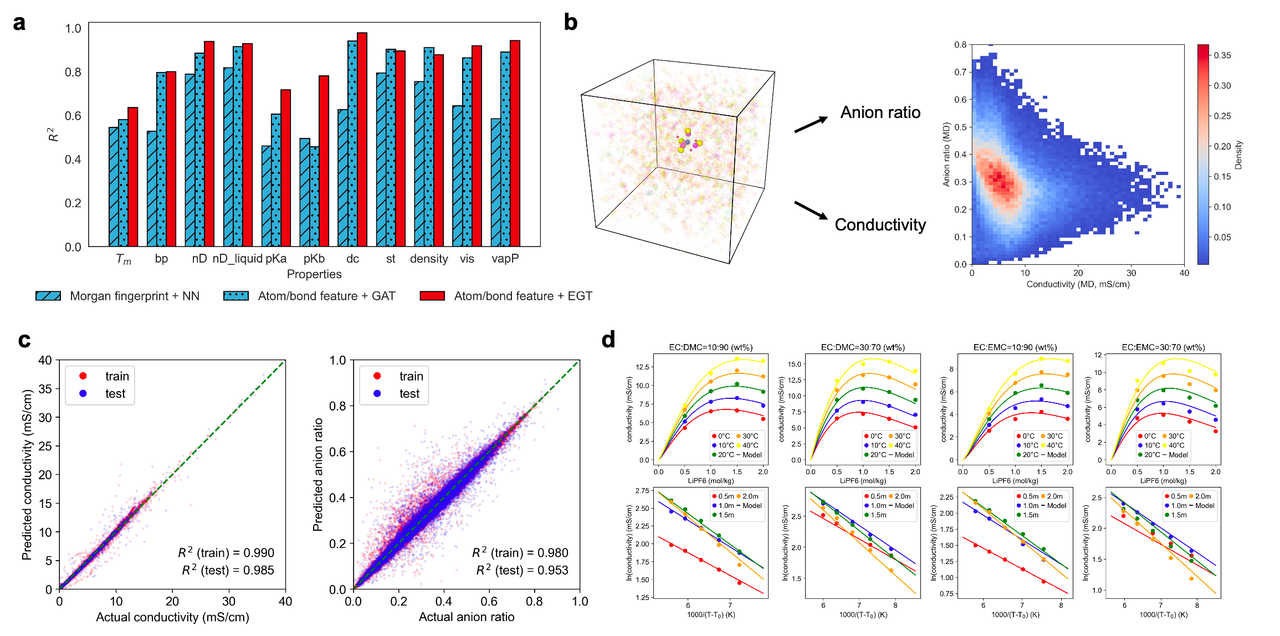
Predictive Performance of BAMBOO-Mix
BAMBOO-Mix can accurately predict electrolyte conductivity and solvation structure while maintaining physical consistency across varying temperatures and concentrations.
3. Partners Co-create Joint Lab, Accelerating Lithium Battery R&D Iterations
Building on their existing collaboration, ByteDance Seed and BYD Lithium Battery will expand their partnership by establishing an AI+ High-Throughput Joint Laboratory. Through sharing algorithms, computing resources, and experimental data, they aim to develop an integrated "dry-wet closed-loop" solution for battery development. This partnership will advance the practical application of AI for Science in lithium battery R&D.
Within this partnership, the ByteDance Seed team will continue to invest in model algorithm research capabilities. Leveraging Volcano Engine's cloud infrastructure, the Seed team will focus on continuous model optimization. Meanwhile, BYD Lithium Battery will provide a high-throughput experimentation platform, which aims to support model refinement by providing quality, large-scale, systematic, and highly consistent experimental data.
Looking ahead, the partnership will also develop AI models that harness massive experimental and computational datasets to evaluate comprehensive battery performance. This will streamline the entire workflow from AI model training and fine-tuning alignment to high-throughput laboratory deployment, thus shortening battery iteration cycles across multiple dimensions and accelerating the discovery of novel materials and formulations.